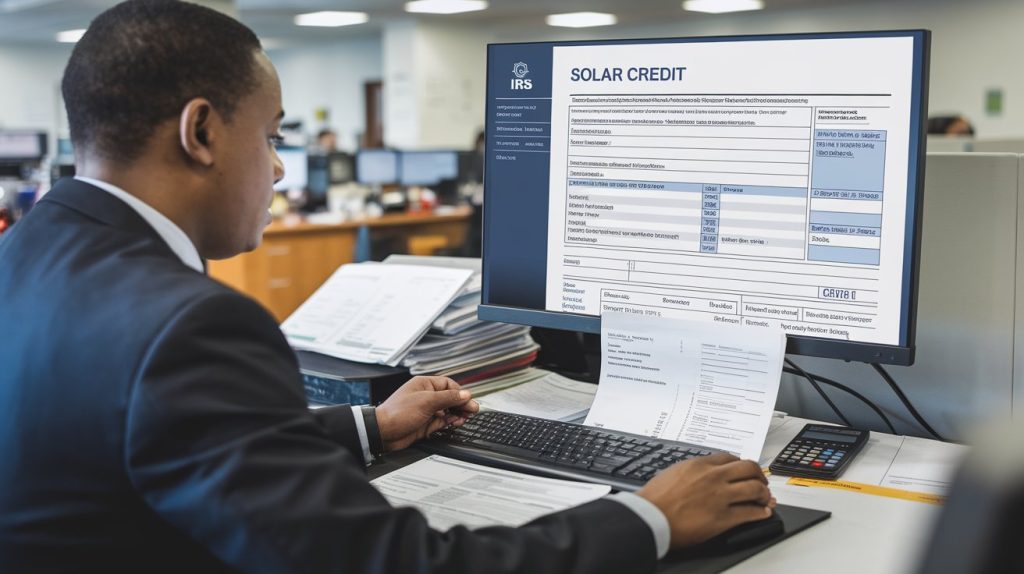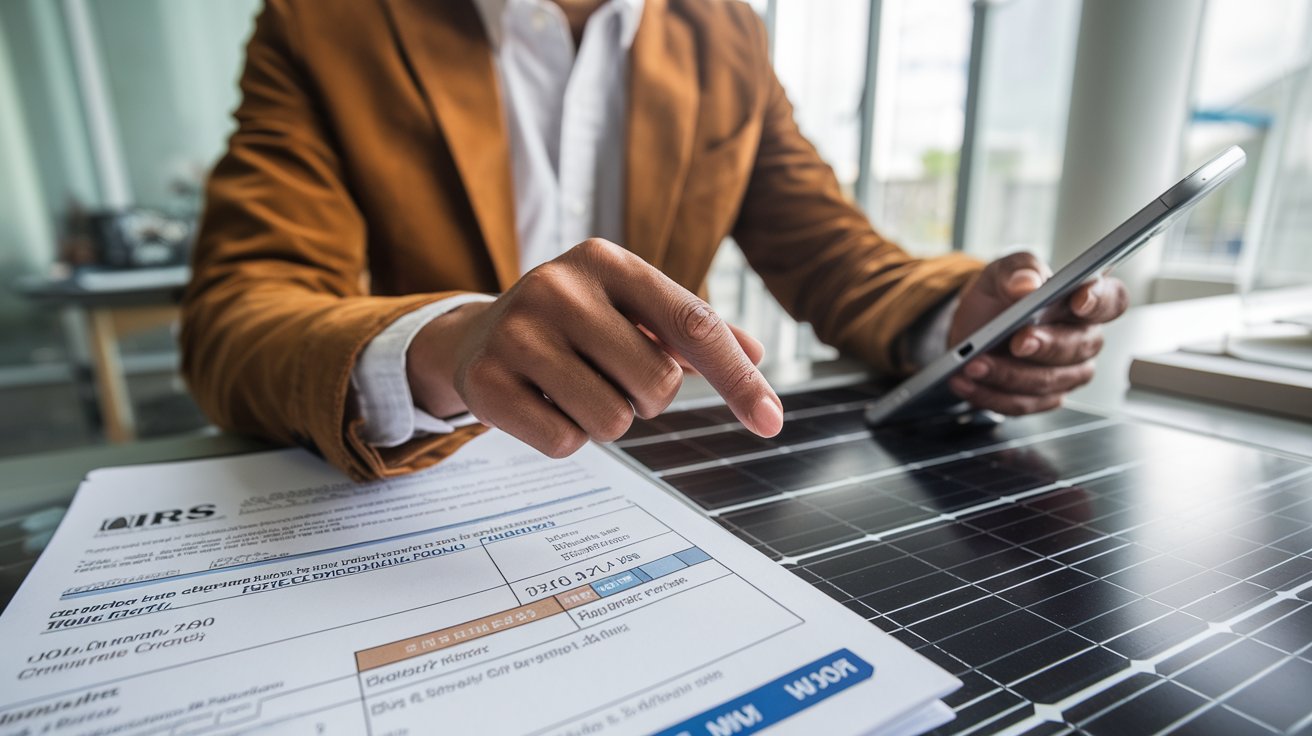Table of Contents
To answer your question, “How does IRS verify solar credit?” you’re not alone. Many homeowners use the federal solar tax credit (the Investment Tax Credit or ITC) to reduce their tax burden while investing in clean energy. Claiming the solar tax credit is relatively straightforward, but understanding how the IRS verifies the credit is crucial to ensuring your smooth approval. How Does IRS Verify Solar Credit? This article will explain how the IRS verifies solar credits, the documentation you need, and tips to ensure everything goes smoothly when you file.

What is the Solar Tax Credit?
How Does IRS Verify Solar Credit? Before discussing how the IRS verifies solar credit, let’s briefly cover the solar tax credit. A portion of the cost of installing a solar energy system can be written off by homeowners in their federal taxes thanks to the federal solar tax credit. How Does IRS Verify Solar Credit This incentive makes solar energy more affordable and encourages the use of renewable energy.
Now, homeowners can claim 30% of their total solar installation costs for systems installed before 2032. How Does IRS Verify Solar Credit? After this date, the percentage will gradually decrease unless Congress extends the program. The credit covers the cost of solar panels, installation, and associated equipment.
How Does the IRS Verify Solar Credit?
Let’s answer the critical question: “How does IRS verify solar credit?” The IRS uses a straightforward process to verify claims for solar tax credits. This is an explanation of how it functions:
Review of Tax Forms
The first step in the verification process is for the IRS to review the tax forms you submit when claiming solar credit. Homeowners must fill out Form 5695 (Residential Energy Credits) when they file their taxes. This form calculates the amount of credit you can receive based on your solar installation costs. How Does IRS Verify Solar Credit? Once you complete Form 5695, the credit amount is entered into your primary tax return (Form 1040).
The IRS cross-checks this form with your overall tax submission to ensure that all calculations are accurate. If the numbers don’t add up, the IRS may flag the return for further review.
Proof of Solar Installation Costs
The IRS requires documentation to verify the total cost of your solar energy system. How Does IRS Verify Solar Credit? This includes invoices, receipts, and contracts related to your solar installation. These documents must show the price you paid for the solar panels, labor, permits, and other associated costs.
While the IRS doesn’t always require you to submit these documents when you file, they may request them if your return is audited. Having these records readily available ensures that you can easily prove the legitimacy of your claim.
Cross-Verification with Contractors
The IRS may verify your solar credit claim by cross-checking your information with the solar contractor or company that installed the system. This could involve verifying that the installation was completed within the eligible time frame and confirming the total costs.
Working with a reputable and certified solar installer is essential to avoid any discrepancies or issues during this verification process.
Also read: How Much Does Towing Cost? Find Affordable Rates Now
Documentation Needed to Claim Solar Credit
How Does IRS Verify Solar Credit? Proper documentation is critical to ensure smooth approval of your solar tax credit. Here are the primary documents you should keep:
Receipts and Invoices
Ensure you have itemized receipts or invoices from your solar contractor showing the total costs of the system and installation. These documents should include a breakdown of equipment costs (such as the solar panels, inverters, and batteries) and labor charges.
Solar Contract
You should save the contract you signed with the solar installation company. This contract provides details on the scope of the project, including the system’s capacity, installation timeline, and payment schedule.
Proof of Payment
Keep a record of how and when you paid for the solar installation. This can include bank statements, credit card receipts, or canceled checks. The IRS may request this information to verify that you paid the expenses and qualify for the tax credit.
Local Permits and Certifications
In many cases, installing a solar energy system requires local permits or certifications. Be sure to keep copies of any licenses or final inspection approvals that you received from your city or county. These documents prove that your installation was completed legally and up to code.
How to Avoid Delays in Your Solar Credit Approval
How Does IRS Verify Solar Credit? To avoid delays or issues with the IRS, follow these tips to ensure your solar credit claim goes smoothly:
Double-Check Your Tax Forms
When filling out Form 5695, ensure the figures you enter match the receipts and invoices from your solar installation. Even minor errors in calculations can lead to delays or rejections.
Work with Certified Installers
Only work with certified and reputable solar installers familiar with the tax credit process. Many contractors will provide a detailed breakdown of the eligible costs, making it easier for you to claim the credit. Certified contractors are also more likely to comply with IRS verification if needed.
Keep All Documentation Organized
While you may not need to submit your solar installation documents with your tax return, having them readily accessible will save you time if the IRS requests them. Organize your receipts, contracts, and permits in a folder to ensure easy access in case of an audit.
File Electronically
Filing your taxes electronically can reduce the risk of errors and expedite the verification process. Many tax software programs have built-in checks that help ensure your Form 5695 is filled out correctly.
What Happens If the IRS Audits Your Solar Credit Claim?
Sometimes, the IRS may audit your return to verify your solar credit claim. This does not imply that you are guilty of anything. Audits are usually random; many are resolved quickly if you have the correct documentation.
During an audit, the IRS will request copies of your receipts, contracts, and other documentation related to the solar credit. If everything is in order, the audit will close without further action. However, if there are discrepancies, the IRS may disallow the credit and adjust your tax return accordingly.
Is Solar Credit Verification Complicated?

Many wonder, “How does IRS verify solar credit, and is it a difficult process?” Verification is generally straightforward as long as you have accurate records and documentation. How Does IRS Verify Solar Credit? The IRS only requires complex calculations or special paperwork beyond Form 5695—most people who follow the proper steps and keep their paperwork in order experience smooth approval without complications.
So, how does the IRS verify solar credit? The process involves:
- Reviewing your tax forms.
- Checking your solar installation receipts and contracts.
- Occasionally cross-verifying with the contractor.
If you have the correct documentation, claiming your solar tax credit should be straightforward and hassle-free.

